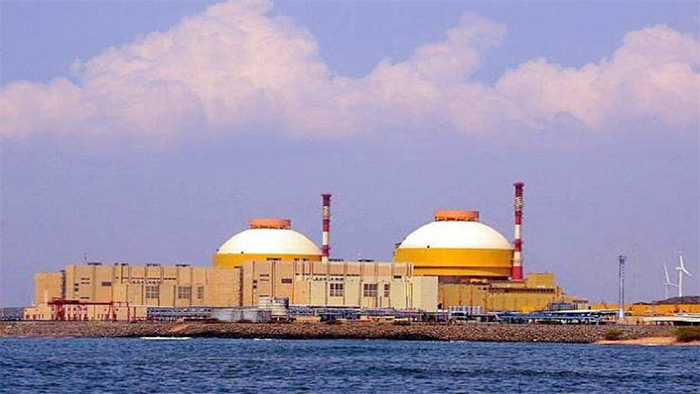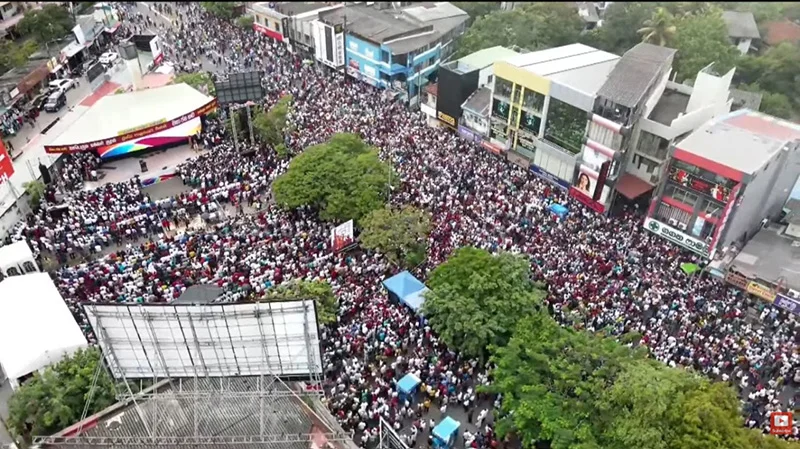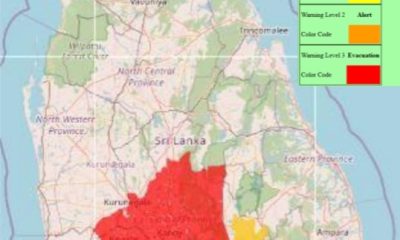Opinion
Nuclear power plants and precautionary principle

By Panduka Karunanayake
While thanking Professor Kirthi Tennakone for his article on nuclear power as an energy option for our country (The Island, May 12), I wish to raise some concerns that were not addressed therein. I don’t have the knowledge of science and a background in the energy sector to be able to answer them myself. But as an ordinary citizen, I think it is a duty to raise these concerns on a matter of such importance.
KT has argued that nuclear energy is reliable, cost-effective and safe (as long as things are running smoothly). While I do not doubt his statements, I have several concerns and they fall into two main categories.
The first category relates to concerns when things are running smoothly. Even if a nuclear power plant has the advantages that he had listed, I worry about two disadvantages. First, where in our country should we site this plant, and what kind of relocation of the population should this require? It may be true that the plant itself would take up only a few square-kilometres, but can ordinary people live right next door to it? Second, how do we dispose of the nuclear waste, where, at what cost and with what consequences? For instance, could radioactive waste leech into underground water tables? How do we monitor that, and what further precautions are necessary to detect and respond to such an event?
I recall an incident more than a decade ago when US environmental scientists detected that radioactive waste from the Cold War era buried deep in the Nevada desert had leached into the water table – but that contaminated water was still 6,000 years from reaching human consumption because the desert is so vast and human beings do not live nearby. (The Nevada desert is 30 million acres, compared to Sri Lanka’s total land area of 16 million acres.)
But the second category of concerns is more important to me. This relates to what might follow if there was a nuclear plant ‘incident’. It probably engenders more speculation and less iron-clad answers, and that might make forming judgements and opinions more fluid and contestable.
KT states that nuclear power plant accidents are very rare and tells us that the Chernobyl and Fukushima incidents are the “only two major mishaps” that have occurred so far. I think that such incidents, whether due to technical failure, mismanagement, human error, sabotage or natural disaster, can and will happen – it’s only a matter of where and when. An important part of planning for something is the planning for such incidents. Although they may be rare, the gravity and consequences of an incident are crucial. The graver the consequences, the more important it is to not dismiss even the rare possibility, and the more important it is to adopt the precautionary principle when forming judgements or making decisions. With this perspective, let me list out some questions.
If such a disaster did happen on Sri Lankan soil at the site that he had identified above, what would be the cost and duration of decontamination? What would be the extent of land, water, air, soil and animal and agricultural produce (including rice, vegetables, meat, fish, eggs and milk) that will have to be given up by us? Can we rely on our regulatory apparatuses to ensure that the food in the market is safe, following such a disaster?
What will happen to tourism? Would the remaining land, air, water, soil, agriculture and animals be enough to sustain the population, or will we have to import our food and even water? Will that be economically feasible, while spending also on decontamination and running without tourism? Who will have access to imported food and water and who will not? What will those without access resort to?
What would be the human health implications to those who survive in terms of disease, birth defects, loss of productivity and cost of treatment? As well as the very likely event of another economic downturn, poverty and malnutrition?
If the radioactive contamination drifts by air to other countries in the region, will we have to pay compensation, and if so, how much?
I think that to face such a “mishap”, a country needs a huge land area, adequate natural resources, enough financial reserves, and good regulatory, administrative and technical apparatuses. I don’t think that the Russian or Japanese examples are contextually appropriate to our setting.
In fact, for several years now, I have been worried about the effects that we ourselves would suffer if the nuclear power plant in South India (which they have sited right at the southernmost part of their huge country, for reasons that are quite understandable). I believe that the wind patterns would probably expose three of our provinces (north-western, north-central and eastern) to radioactive fallout. We should therefore be ready for a nuclear power plant accident even without having one – and we aren’t. That is the sort of ‘planning’ that we are capable of!
Opinion
Maha Jana Handa at Nugegoda, cyclone destruction, and contenders positioning for power in post-NPP Sri Lanka – I

The Joint Opposition rally dubbed the ‘Maha Jana Handa’ (Vox Populi/ Voice of the People) held at the Ananda Samarakoon Open Air Theatre, Nugegoda on 21 November, 2025 has suddenly acquired a growing potential to be remembered as a significant turning point in post-civil conflict Sri Lankan politics, in the wake of the meteorological catastrophe caused by the calamitous Ditwah cyclonic storm that devastated the whole country from north to south and east to west on an unprecedented scale. But the strength of this prospect depends on the collective coordinated success of the future public awareness raising rallies, promised by the participating opposition parties, against the incumbent JVP-led NPP government. They are set to expose what they perceive as the government’s utterly inexperienced and unexpectedly authoritarian stand on certain vitally important issues including the country’s national security and independence, political and economic stability, and the Lankan state’s unitary status. The government is also alleged to be moving towards establishing a form of old-fashioned single party Marxist dictatorship in place of the firmly established system of governance based on parliamentary democracy, which was almost toppled by the adventitious Aragalaya protest of 2022 but saved by the timely intervention of some patriotic elements.
The minefield of policy making that the government must negotiate is strewn with issues including, among others: the seven or so recent agreements or MOUs (?) secretly signed with India; the unresolved controversy over the allegedly illegal clearance of some 323 containers (with unknown goods) without mandatory Customs inspection, from the Colombo Port; the Prime Minister’s arbitrary, apparently ill-considered and hasty education reforms without proper parliamentary discussion; the proposed culturally sensitive lgbtqia+ legislation non-issue (it is a non-issue for Sri Lanka, given its dominant culture); the so-called IMF debt trap; dealing with the unfair, virtually unilateral UNHRC resolutions against Sri Lanka; the inexplicably submissive surrender of the control of the profit-making Colombo Dockyard PLC to India; some government personal assets declarations that have raised many eyebrows, and the government’s handling of anti-narcotic and anti-corruption operations. The opposition politicians relentlessly criticise the ruling JVP/NPP’s failure to come out clean on these matters. But they themselves are not likely to be on an easy wicket if challenged to reveal their own positions regarding the above-mentioned issues.
In addition to those problems, the much more formidable challenge of unsolicited foreign-power interference in Sri Lanka’s internal affairs, in the guise of friendly intervention, remains an unavoidable circumstance that we are required to survive in the geostrategically sensitive region where Sri Lanka is located. Having been active right from the departure of the British colonialists in 1948, the foreign interference menace intensified after the successful ending of armed separatist terrorism in 2009. Such external interferences are locally assisted by latent domestic communal disharmony as well as real political factionalism, both of which are normal in any democratic country.
The war-winning President Mahinda Rajapaksa, as the leader of the SLFP-led United People’s Freedom Alliance (UPFA), was made to suffer a largely unexpected electoral defeat in 2015 through a foreign-engineered regime change operation that tacitly favoured his key rival, UNP leader Ranil Wickremesinghe. Mahinda was betrayed by his most trusted lieutenant Maithripala Sirisena.
The SLFP, a more middle of the way socialist-leaning rival political party, was formed in September 1951—five years after the birth of the UNP—and was elected to power in 1956, ending a near decade under the rather West-friendly latter party. It was deemed to be a ‘revolution’ that started an era of ‘transition’ (from elitist to common citizen rule). From nominal independence in 1948, governing power has to date alternated between these two parties or alliances led by them, except for the last electoral year, 2024. Though incumbent Executive President Anura Kumara Dissanayake may be said to have made history in this sense, the fact remains that he was barely able to scrape just 43% of the popular vote as the head of a newly formed, JVP-led NPP. Dissanayake was sworn in as President in September 2024. But his less than convincing electoral approval triggered a massive victory for the NPP at the parliamentary election that followed in November, giving him a parliament with 159 members, which is unprecedented in Sri Lanka’s electoral history.
In my opinion, there are two main reasons for this outcome. One is that the average Sri Lankan voters trust democracy. Since the president elect is accepted as having won the favour of the majority of the pan-Sri Lankan electorate, the general public choose to forget about their personal party affiliations and tend to vote for the parliamentary candidates from the party of the elected president. This is particularly true of the majority Sinhalese Buddhist community represented by the two mainstream, non-communal national parties, the UNP and the SLFP. The brittle foundation of that victory is not likely to sustain a strong enough administration that is capable of introducing the nebulous ‘system change’ that they have promised in their manifesto, while it is becoming clear that the general performance of the government seems to be falling far short of the real public expectations, which are not identical with the unconscionable demands made by the few separatist elements among the peaceful Tamil diaspora in the West, to whom the JVP/NPP alliance seems to owe its significantly qualified electoral success in 2024.
The Maha Jana Handa reminded me of the long Janabalaya Protest March from Kandy to Colombo where it ended in a mass rally on September 5, 2018. That hugely successful event was organised by the youth wing of the SLPP led by Namal Rajapaksa, who was an Opposition MP during the Yahapalanaya. He has played the same role just as efficiently on the most recent occasion, too. At the end of his address during the Maha Jana Handa, he declared his determination to bring down the malfunctioning JVP/NPP government at the earliest instance possible. Probably, he missed Ranil’s protege Harin Fernando’s speech that came earlier. This was because Namal Rajapaksa joined the rally midway. Harin had brought a message from his mentor Ranil to be read out to the rally audience. But he said he didn’t want to do so after all, saying that it was not suitable for that moment. Anyway, during his speech, Harin said emphatically that the era of heirs apparent or crown princes was gone for good. People knew that he was alluding to Sajith Premadasa and Namal Rajapaksa (sons of former Presidents hopeful of succeeding Anura Kumara Dissanayake). Harin was seen biting his tongue or sticking it out a little as he was preparing to leave the stage at the end of his address. Was he regretting what he had just said or was he cocking a snook at what, he was sure, was Namal’s ambition that would be revealed in his speech, the rally having been organised by the Pohottuwa or the SLPP? (To be continued)
by Rohana R. Wasala
Opinion
Lessons that should be learnt from Ditwah

Cyclonic storm Ditwah, named as such by Yemen referring to Detwah lagoon in one of its islands, caused severe devastation in Sri Lanka though it was categorised a weak tropical cyclone. When it hit on Thursday 27th November, the main problem was the unprecedented rain, some areas experiencing over 500 millimetres in 24 hours. Fortunately, wind speeds were not high reaching a maximum of only 45 mph, the sort of wind speed not infrequently encountered in the UK. In contrast, Hurricane Melissa, a category 5 storm which struck Jamaica, just a month ago, had winds reaching 185 mph! Though it was the most powerful storm to hit Jamaica ever, causing extensive damage across the island due to strong winds with added torrential rainfall causing landslides, the death toll was only 54 with further 15 people reported missing. It affected Cuba, Dominican Republic, and Haiti as well, with a further 48 deaths. Jamaicans were forewarned and were well prepared. It looks as if this did not happen in Sri Lanka. Though politicians are fighting over this aspect, despite it being not the priority, it is never too early to learn lessons. My comments that follow should not, in any way, detract from the very positive actions the government has taken and continues to do so, as well as the heroic efforts of volunteers putting their own lives at risk.
I did not realise the enormity till Friday (28) evening, when Ven. Teldeniyaye Amitha, who conducts a fortnightly Mindfulness meditation session over Zoom, told the participants that we should instead do Kindness meditation in view of the catastrophic situation in Sri Lanka. As soon as the session was over, I switched on to YouTube and was shocked by the images of destruction seen. When I contacted a good friend of mine in Kandy on Saturday 29th afternoon, what he told me made me realise that there were no warnings at all.
This lack of warning was not due to information being not available, I learned later. In fact, the DG of Meteorology has warned of an impending catastrophe when inclement weather was discussed on “Big Focus” programme broadcast over Derana TV on 12th November, in the presence of the DG of the Disaster Management Centre (DMC). It also further transpires that BBC World Service, the day before, accurately predicted that Cyclone Ditwah will cause heavy rainfall, up to 500mm, in Sri Lanka. Thus, there is no doubt that the government failed in its duty of adequate warning and taking action to minimise damage. Perhaps, it may have something to do with their labelling the DMC a ‘White Elephant’ in the past and threatening to dismantle it. Meteorological department’s lack of latest radar equipment is no excuse as information could be obtained from many sources. Some scientists whose sympathies are with the governing party seem to pronounce that weather predictions are unreliable. This may be so in the long term but, surely, BBC’s prediction the previous day, as well as the regular warnings sent by the Meteorological Service of India, should have been taken seriously. It is a great shame that the government does not seem prepared to admit that it made a mistake. Without that lessons cannot be learned!
It was disgusting to see a lady MP, who seems to be a loose cannon, having the audacity in parliament to blame Derana TV for broadcasting that programme! If true, it is more worrying that an opposition MP has stated in parliament that the Secretary of Defence has threatened the DG of Meteorology. In the latest turn of events, Deputy Minister Mahinda Jayasinghe has stated that the opposition should be sued for being silent on the weather warning! Does he not realise that by such loose talk he is helping the government to dig its own grave!
The other important question is whether the opening of sluice gates of reservoirs contributed to death and destruction. Some experts opine that had sluice gates been opened in advance to accommodate the expected torrential downpour, a significant amount of destruction and some deaths could have been avoided. This needs careful study, not to apportion blame, but to make sure that any future recurrences could be prevented. Considering the global changes in weather experienced, whatever the reason may be, we need to be prepared for this type of eventuality.
At a time of an unprecedented national emergency when cooperation of all was needed, the mudslinging on social media, both by supporters and opponents of the government, was despicable. There seems to be some truth to the accusations that the governing party goons hindered attempts by the opposition to help the affected, to claim credit for themselves! Do they think people in distress care whether ‘red stars’ are attached to aid packets?
The fact that the government seems incapable of taking criticism was made obvious by the actions of the Deputy Minister of Public Security. Though his Minister and the President subsequently denied that emergency powers would be used to suppress dissent,Watagala’s despicable behaviour, as well stated in the editorial “Emergency turns Jekyll into Hyde” (The Island, 5 December), deserves condemnation. There is a well justified suspicion that the Police are behaving as a paw of the ruling party, as two police officers with shadows over them were, plucked out of retirement, unashamedly appointed to two key positions as a reward for their political campaigning.
Perhaps, the comments made by Jaffna district MP, Dr Archchuna should make the government rethink, leave the past behind and act rationally. He told parliament that he had been rescued by Sinhala war heroes and sheltered in a Navy camp, criticising the government for insulting the armed forces. Considering the yeoman’s service rendered by the tri forces during this catastrophe, it is high time the governing party realised that service personnel are required at other times too, not only during war, and that they deserve the gratitude and the respect of the nation for saving us from terrorism too.
The best way to honour those who died during the recent disasters is by learning lessons from this tragedy so that we would be better equipped for any future emergencies. This could be done only if the government is prepared to eat humble pie and admit that mistakes were made. Do sincerely hope that they are big enough, and humble too, to do so!
By Dr Upul Wijayawardhana
Opinion
A 6th Year Accolade: The eternal opulence of my fair lady

The 6th of December marked the sixth solar cycle since my adored life partner, Dr Malwattage Josephine Sarojini Perera (née Peeris), left this mortal world. Six years have elapsed; a period characterised by a searingly perpetual heartache. However, her inspiring influence is not diminished by the passage of time, and her memory has become more burnished and sublimely potent. It has transformed from a painful void into a sparkling, indestructible legacy that fortifies the hearts of all who were privileged to share her path.
The abyss left by her departure is multitudinous for all of us, including those who benefited from her professional dedication. Nevertheless, the consciousness of her magnificent journey, a spectacular 72 years, 2 months, and 11 days on this planet Earth, remains as a seamless record of a unique chronicle. It was the radiance of her inner spirit that rendered her truly peerless. She epitomised the beautiful words of one of my favourite Sri Lankan lady singers, “Beauty is how you feel inside; you glow from within.” Sarojini was a woman of monumental dignity and benevolence, whose serene, consistent luminosity brought a radiance into every room she entered. Her smile was a glorious spectacle of her lovely inner human nature; a pure expression of her soul’s integrity. That spectacularly radiant smile epitomised the immortal words of the beautiful song by Nat King Cole, “Smile though your heart is aching, smile even though it is breaking, when there are clouds in the sky, you will get by.“
Throughout her tenure on earth, she embodied the highest form of selfless service, dedicating her energies wholly to our family unit, her relatives, and all her acquaintances. She served her patients with an unreserved commitment, functioning as the very milieu of abiding reassurance for them. Her chosen field in medicine was one of profound challenges and pressing needs. She primarily worked ever so tirelessly with individuals afflicted and affected by Sexually transmitted Diseases, HIV and AIDS. They were a cohort frequently marginalised, ostracised, and terribly wounded by societal judgment. Yet, this extraordinary woman approached her work with limitless compassion and an intrinsic, deep-seated sense of humanitarian duty. She held an irrefutable conviction that beyond the stark finality of any medical diagnosis, there was a human being whose entitlement to honour, consideration, respect and warmth was absolute.
Sophocles wisely said: “One word frees us of all the weight and pain of life: That word is love.” Sarojini’s approach to life was built upon this very word ‘love’ as its foundation. She remained steadfastly true to her ethical moorings, never wavering in her commitment to assuage suffering and nurture genuine understanding. Her patients were not mere cases receiving clinical attention; they were embraced into a circle of care that extended beyond the confines of the clinic. Sarojini’s gentle disposition and empathetic spirit captivated all those who came seeking relief and comfort in her ministrations.
She extended not only medical expertise but also essential emotional ballast, serving as a critical beacon of optimism in times of the most profound darkness and utter despair. Her engagement was holistic; she saw the complete person, not just the disease. The philosopher Kahlil Gibran expressed a sentiment that describes the core values of her life: “You give but little when you give of your possessions. It is when you give of yourself that you truly give.” Her affection emanated as a gentle, regenerative anodyne, calming the distressed spirits of those sighing in overwhelming heartache. Her bequest in this vital domain of medicine is not merely a record of treatments, but a register of hearts healed and spirits uplifted by unconditional acceptance and love.
Beyond her professional life, Sarojini was the gravitational centre of our existence; a loving spouse, an undaunted mother, and a precious confidante. The habitat and the canvas of love we built together were a haven of affection and composure, a place where joy thrived, and the air was often vibrant with shared merriment. She cultivated her family with boundless tenderness, sowing and nurturing the essential precepts of benevolence, rectitude, and resilience within us. In return, we never made her cry, but sometimes she cried for others, and some made her cry too.
Her capacity for quiet strength was remarkable; she could maintain perfect equilibrium even when confronted with severe setbacks, always taking deliberate, measured steps to restore serenity and balance. Her affection is a vibrant force that persists in the deepest recesses of our hearts, a covenant that triumphantly surpasses the limitations of physical existence and the transience of life. The deep impact of her role as a matriarch cannot be overstated; she was the silent architect of our moral framework and emotional stability, and the queen of our hearts.
As we reflect on her exceptional life and the vast bounty of goodness she left behind, our determination is not to be subdued by the grief of her physical absence, but rather, to eulogise the radiant splendour of her time amongst us. It is a legacy beyond epithets and the true portrayal of the lilting music of remembrance. We feel the unremitting pain of missing her absolutely and profoundly. She may have transitioned from this worldly realm, but her vital essence remains inextricably bound to ours, steering us with her quiet wisdom and inspiring us with her incomparable dignity. Sarojini’s life stands as an eternal affidavit to the transformative power of enduring love, deep empathy, and sacrificial duty. It remains a boon that richly augments our present and illuminates our future. True beauty, as she demonstrated, is not simply what the eyes can witness, but, more crucially, what the soul can permanently safeguard. What we perceive visually is destined to fade, but the treasures we store within our hearts will remain eternally.
Many, including myself, our daughter Maneesha and our grandchildren, Joshua, Malaika and Jaydon, have endeavoured with every available adjective and hyperbolic utterance to paint a faithful portrait of the superlative person that was Sarojini. Yet, even if we were to compile tomes detailing her excellence, the effort would still fall short of creating a realistic depiction that truly captures her profile. It is simply impossible to confine a description of her magnificence to even a substantial plethora of words.
For my part, I had the wonderful pleasure of the company of that stunning lady for all those blessed years, from the dawn of our courtship in 1973 until her fateful day of final rest. Despite the finality of that separation, memories remain the ultimate constant. I will forever recall her life as an exquisite and enduring strand, a beautiful composition, that will never diminish and will reverberate throughout the balance of my time on this planet Earth.
Sarojini, your loved ones strive daily to revere your memory by actively embodying the virtues you demonstrated so effortlessly: boundless compassion, humane benevolence, unbridled affection, and an unwavering commitment to the welfare of others. This is a matter of seminal importance to us, as it is a pledge towards the continuity of the very matrix of your tapestry of life on Mother Earth.
Darling Sara, I will end with a couple of lines from the 1996 Quadruple Chart Topper, “Because You Loved Me” by Celine Dion, which very concisely sums up what you were to me: –
“You’ve been my inspiration.
Through the lies, you were the truth.
My world is a better place because of you.”
by Dr B. J. C. Perera
(This appreciation appeared in The Island online edition on 06 Dec. 2025)
-
News6 days ago
Lunuwila tragedy not caused by those videoing Bell 212: SLAF
-

 News1 day ago
News1 day agoOver 35,000 drug offenders nabbed in 36 days
-

 News5 days ago
News5 days agoLevel III landslide early warning continue to be in force in the districts of Kandy, Kegalle, Kurunegala and Matale
-

 Business3 days ago
Business3 days agoLOLC Finance Factoring powers business growth
-

 News3 days ago
News3 days agoCPC delegation meets JVP for talks on disaster response
-

 News3 days ago
News3 days agoA 6th Year Accolade: The Eternal Opulence of My Fair Lady
-

 News1 day ago
News1 day agoRising water level in Malwathu Oya triggers alert in Thanthirimale
-

 Midweek Review6 days ago
Midweek Review6 days agoHouse erupts over Met Chief’s 12 Nov unheeded warning about cyclone Ditwah













